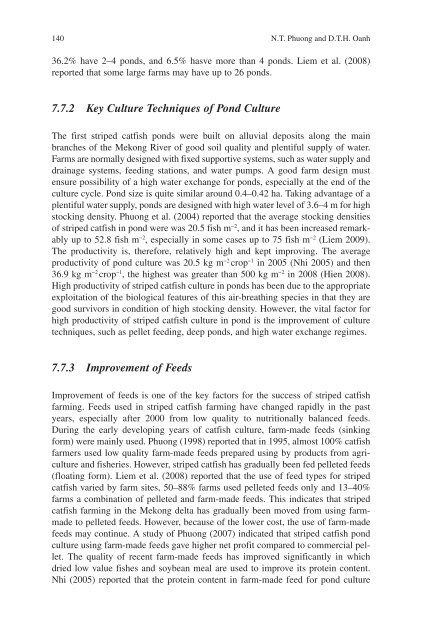Success Stories In Asian Aquaculture - Library - Network of ...
Success Stories In Asian Aquaculture - Library - Network of ...
Success Stories In Asian Aquaculture - Library - Network of ...
- No tags were found...
You also want an ePaper? Increase the reach of your titles
YUMPU automatically turns print PDFs into web optimized ePapers that Google loves.
140 N.T. Phuong and D.T.H. Oanh36.2% have 2–4 ponds, and 6.5% hasve more than 4 ponds. Liem et al. (2008)reported that some large farms may have up to 26 ponds.7.7.2 Key Culture Techniques <strong>of</strong> Pond CultureThe first striped catfish ponds were built on alluvial deposits along the mainbranches <strong>of</strong> the Mekong River <strong>of</strong> good soil quality and plentiful supply <strong>of</strong> water.Farms are normally designed with fixed supportive systems, such as water supply anddrainage systems, feeding stations, and water pumps. A good farm design mustensure possibility <strong>of</strong> a high water exchange for ponds, especially at the end <strong>of</strong> theculture cycle. Pond size is quite similar around 0.4–0.42 ha. Taking advantage <strong>of</strong> aplentiful water supply, ponds are designed with high water level <strong>of</strong> 3.6–4 m for highstocking density. Phuong et al. (2004) reported that the average stocking densities<strong>of</strong> striped catfish in pond were was 20.5 fish m −2 , and it has been increased remarkablyup to 52.8 fish m −2 , especially in some cases up to 75 fish m −2 (Liem 2009) .The productivity is, therefore, relatively high and kept improving. The averageproductivity <strong>of</strong> pond culture was 20.5 kg m −2 crop −1 in 2005 (Nhi 2005) and then36.9 kg m −2 crop −1 , the highest was greater than 500 kg m −2 in 2008 (Hien 2008) .High productivity <strong>of</strong> striped catfish culture in ponds has been due to the appropriateexploitation <strong>of</strong> the biological features <strong>of</strong> this air-breathing species in that they aregood survivors in condition <strong>of</strong> high stocking density. However, the vital factor forhigh productivity <strong>of</strong> striped catfish culture in pond is the improvement <strong>of</strong> culturetechniques, such as pellet feeding, deep ponds, and high water exchange regimes.7.7.3 Improvement <strong>of</strong> FeedsImprovement <strong>of</strong> feeds is one <strong>of</strong> the key factors for the success <strong>of</strong> striped catfishfarming. Feeds used in striped catfish farming have changed rapidly in the pastyears, especially after 2000 from low quality to nutritionally balanced feeds.During the early developing years <strong>of</strong> catfish culture, farm-made feeds (sinkingform) were mainly used. Phuong (1998) reported that in 1995, almost 100% catfishfarmers used low quality farm-made feeds prepared using by products from agricultureand fisheries. However, striped catfish has gradually been fed pelleted feeds(floating form). Liem et al. (2008) reported that the use <strong>of</strong> feed types for stripedcatfish varied by farm sites, 50–88% farms used pelleted feeds only and 13–40%farms a combination <strong>of</strong> pelleted and farm-made feeds. This indicates that stripedcatfish farming in the Mekong delta has gradually been moved from using farmmadeto pelleted feeds. However, because <strong>of</strong> the lower cost, the use <strong>of</strong> farm-madefeeds may continue. A study <strong>of</strong> Phuong (2007) indicated that striped catfish pondculture using farm-made feeds gave higher net pr<strong>of</strong>it compared to commercial pellet.The quality <strong>of</strong> recent farm-made feeds has improved significantly in whichdried low value fishes and soybean meal are used to improve its protein content.Nhi (2005) reported that the protein content in farm-made feed for pond culture
















